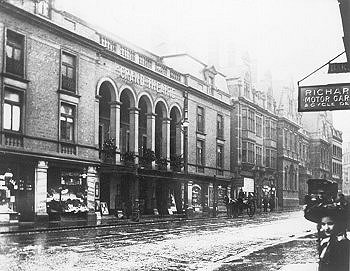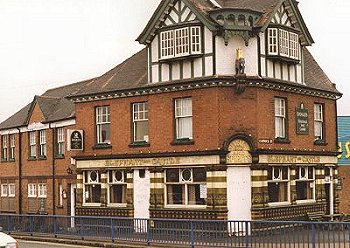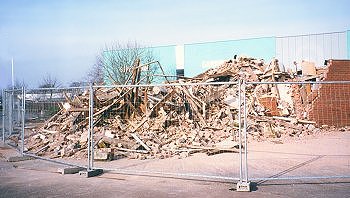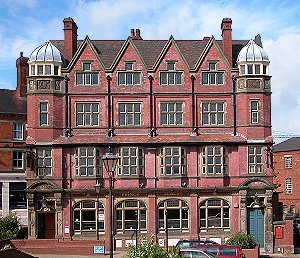|
Entertainment and Leisure
Like
all major towns, Wolverhampton was well supplied with places of
entertainment. Unfortunately only one of these, The Grand
Theatre, remains from the town’s 19th century theatres. In
Bilston Street was the Star Theatre and Concert Hall, which was
built in the Elizabethan style and entirely rebuilt in 1883. In
Cleveland Road was the Theatre Royal erected in 1844. The
original theatre was at the top of the Swan Hotel yard in Queen
Square (or High Green as it was then) and was built about 1779.
Mrs. Siddons performed there on many occasions and legend has it
that the great tragedian John Kemble made his acting debut
there.
Music
Halls, few of which have survived, were thought of as subversive
places of entertainment as well as places of beer and gin. What
is not often realised is that they were often quite political
where one was as likely to hear a parodied version of a popular
Jingoistic song as the real thing.
Any
discussion of Wolverhampton buildings used for entertainment
must begin with the Grand Theatre. It has been described as
”the finest miniature opera house in Europe” and few would
quibble with that description. A few years ago when it appeared
that this delightful building was in danger of never opening
again, many people felt a sense of almost personal loss. Like
many local people, the writer’s earliest theatrical experiences
were all at the Grand.
|
|

The Grand Theatre, Lichfield Street. |
The decision
to build the theatre in Lichfield Street had been made as early as
February 1894 by the then mayor C.T. Mander, who was the driving
force behind the scheme, and about six others. The site was
important for the theatre; it was near the town centre, on a main
thoroughfare and next door to the hotel, which had been enlarged to
make it a first class establishment. The proprietors of the Victoria
Hotel were quite pleased that there was going to be a new theatre on
their doorstep and shareholders were encouraged to buy an interest
in the new place of entertainment. |
|
The
actual building of the theatre was entrusted to the
Wolverhampton firm of William Gough, who took only six months to
complete the work after the laying of the foundation stone by
Mrs. C.T. Mander. The theatre is a product of the “naughty
nineties”, being built between 1893 and 1894 to a design by the
architect C.J. Phipps, one of the first architects to specialise
in theatre design. It was designed to seat 2, 500 people and
cost £12,000. Phipps was a prolific theatre designer and his
other commissions include the Savoy Theatre and Nottingham’s
Theatre Royal. The Grand Theatre also incorporated four shops,
two on either side of the entrance which is 123 feet across.
The
opening night of the theatre was on December 10th 1894 with a
performance by the D’Oyle Carte Opera Company performing Gilbert
and Sullivan’s Utopia Unlimited.
|
|
The
latter years of the 19th century were a golden age of theatre
building. It is strange that the times of the greatest theatre
building do not always coincide with periods of great dramatic
writing. Theatre architecture is very much linked with the
social climate of the day because it is a social art. Play
writing in the 19th century before the arrival of Chekhov, Ibsen
and Shaw was at low ebb. However playwrights such as these often
had conflicting aims, which were in conflict with those of
theatre architects. The latter were concerned with creating an
environment to accommodate all levels of society; the great
dramatists were intent on reform and social examination as well
as entertainment.
The
façade of the Grand has a continental look with a five bay upper
loggia of arcading. A cast iron porte-cochere extends over the
pavement. Inside there are deeply recessed balconies fronted by
ornate stucco work.
|

The Hippodrome, Bilston Street. |
| Like all
theatres, the Grand reflected social divisions; different bars,
entrances and toilets for the patrons of different parts of the
house.
It was
whilst performing at the Grand Theatre in February 1905 that Sir
Henry Irving was attacked by the serious illness which
terminated fatally at Bradford later in the year. The young
Charlie Chaplin was recorded as a call boy in 1902 and he also
starred at the Grand in one of his first acting debuts as Dr
Watson’s page boy (!) in Sherlock Homes.
Many
Victorian theatres and music halls have either been destroyed or
insensitively “adapted”. Wolverhampton is fortunate in retaining
the Grand.
|
|

The Elephant and Castle that was in Stafford
Street.
|
There are in
Wolverhampton some fine examples of pub architecture, although many
have gone and those remaining do not contain their original
fittings. Although some people get very romantic about good pub
buildings, it should be remembered that they had one function and
one function only and that was to sell beer and make as much money
as possible. Many underhand methods were employed to make people
drink more, including adding salt to the brew. (Now pubs just sell a
wide range of salty snacks). |
| In the 19th
century the brewery interest was very powerful and not for nothing
was it known as the “Beerage”. There are in Wolverhampton some fine
examples of pub architecture, although many have gone and those
remaining do not contain their original fittings. |
| One of the
best examples of pub architecture was the Elephant and Castle just
off the Ring Road. The façade was of exuberant green glazed brick.
For a sign it had a splendid model of its name on the corner. The
tiling was perfect and extremely well-preserved with the name of the
pub written on the two sides facing the two roads. Above the doorway
was written Wines and Spirits in ceramics of the very highest order
of quality. |

What remained of the beautiful and much
loved Elephant and Castle after its hasty demolition. |
| There was a
projecting black and white gable above the model sign and below that
a decorative border. The Elephant and Castle achieved the brewery’s
main aim which was to create a landmark building. The Elephant was
not only one of the most famous buildings in Wolverhampton but also
one of the best loved.
In the City centre, the
recently refurbished Posada still retains many of its original
features, including the glazed tiles below the window and
inside, but most of all the beautiful Art Nouveau lettering of
its name above the window and down the side entrance. The Prince
Albert and Sir Tatton Sykes are both good examples of imposing
late Victorian pubs. The former is one of our favourite façades
having as it does an excellent symmetry. At the top are two
cupolas on either side of four steep gables. Each of the storeys
uses a different design for its four windows. The first storey
windows are bowed and those at the ground floor have arches. The
two doorways either side of the building complete the symmetry. |
|

The Prince Albert pub.
|
Recently the Town hall Tavern has been refurbished and
renovated. One outcome of this was the removal of plaster work
above the first floor which revealed a row of exquisite sky-blue
tiles, some patterned, some with fleurs-de-lis, others having
letters making up the legend “Wine and Spirit Merchant”.
Entwined numbers in stone above the door give the date 1874.
Although the inside of the pub has been ruthlessly altered, the
façade of the Old Still retains its ability to impress,
guarding as it does the entrance to King Street, a street that
can probably still boast of being one of Wolverhampton’s most
elegant streets.
|
|
The
Exchange in Cheapside was recently vandalised when the old
fixtures and fittings were torn out to be replaced by imitation
old fixtures and fittings. Progress of a sort one supposes.1
Unfortunately, many of Wolverhampton's Victorian pubs
disappeared during the construction of the Ring Road. I would
pick out five, the first being the Blue Ball at the end of
Pipers Row.
Notes:
| 1. |
It is
strange how some breweries (not of course Wolverhampton’s
premier brewery) deliberately trade on their old fashioned
traditional image and at the same time have engaged in
architectural vandalism and philistinism on a breathtaking
scale. How
people who harp on their “heritage” can so ruthlessly
destroy and disguise it is a mystery. When one local pub was
undergoing a particularly ruthless transformation into a
Giggle Palace or Fun Factory, I wrote to the brewery
concerned and asked if the beautiful plaster mouldings,
brass work, heavy oak doors and etched windows had at least
been passed on to a dealer in architectural antiques. The
reply expressed blank amazement that anyone should have
asked such a ridiculous and naive question. |
|
 |
 |
 |
Return to
Banks and Offices |
Return to the
contents |
Proceed to
Architects
and Craftsmen |
|